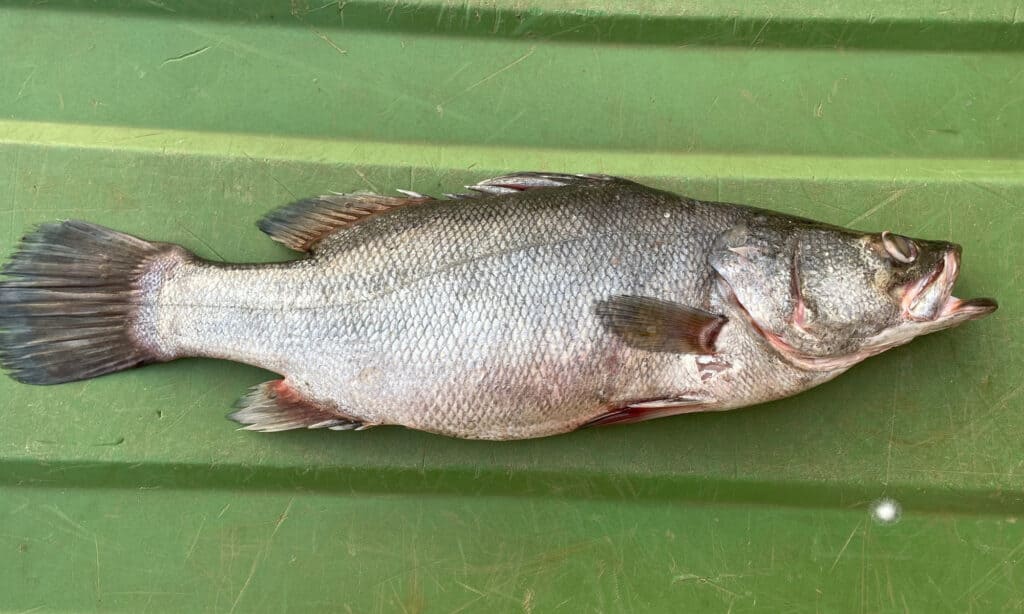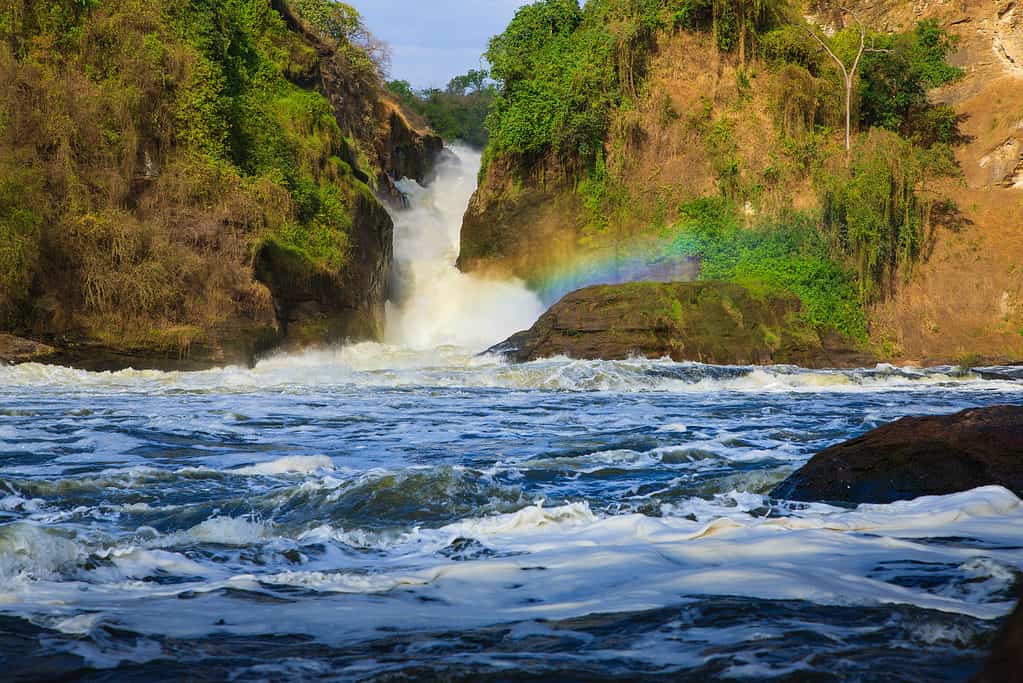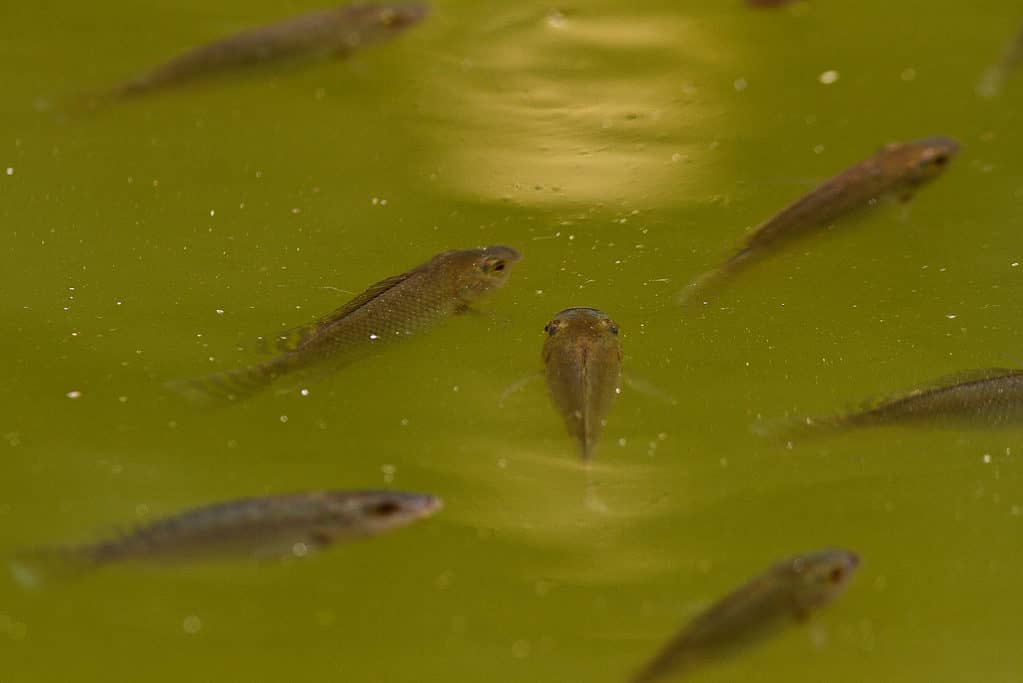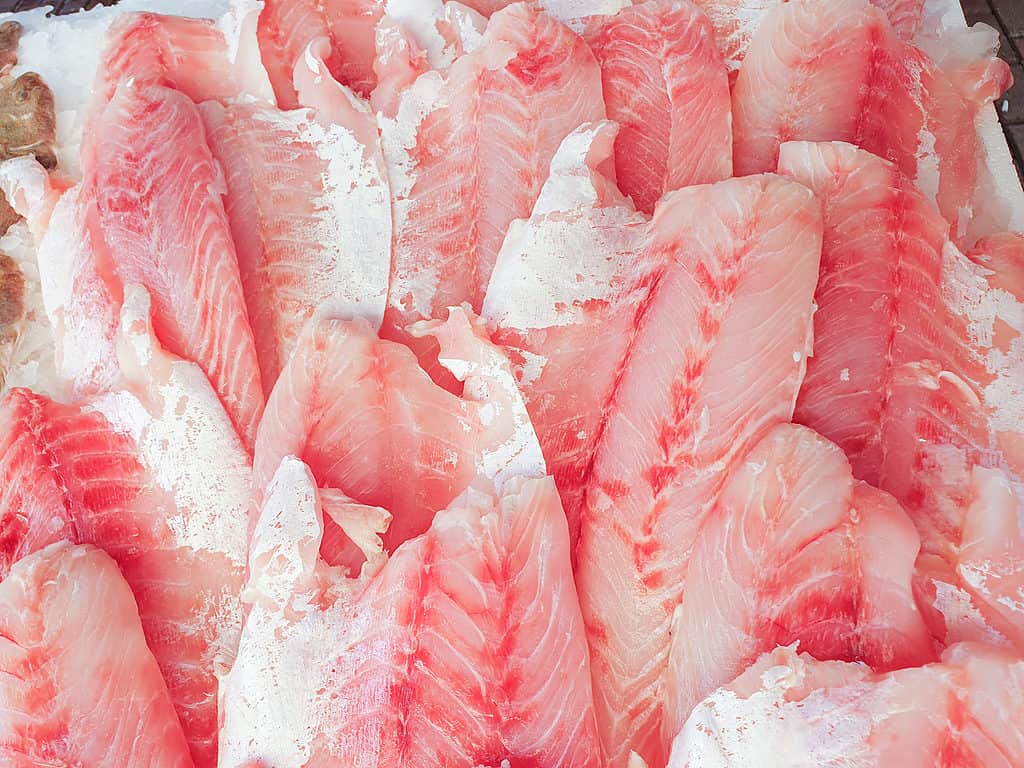Nile Perch
Lates niloticus
Nile perch will sometimes eat those within its own species
Advertisement
Nile Perch Facts
- Prey
- Fish, crustaceans, snails, clams, insects, mollusks
- Fun Fact
- Nile perch will sometimes eat those within its own species
- Biggest Threat
- Overfishing
- Most Distinctive Feature
- Yellow outline around black pupils
- Distinctive Feature
- Silver scales with hints green or blue coloration
- Other Name(s)
- African Snook
- Gestation Period
- 20 hours
- Litter Size
- 3 million to 15 million
- Habitat
- lakes, streams, ponds, rivers, marshes
- Predators
- bayad, african butter catfish
- Average Litter Size
- 9 million
- Common Name
- Nile perch
- Origin
- Ethiopian region of Africa
- Location
- Lake Victoria, Nile River Basin
Nile Perch Physical Characteristics
- Color
- Blue
- Green
- Silver
- Skin Type
- Scales
- Lifespan
- 16 years
- Age of Sexual Maturity
- three years
View all of the Nile Perch images!
Nile Perch Summary
The Nile perch is a freshwater fish species native to the Ethiopian region on the African continent. After its introduction to Lake Victoria in the mid-1900s, the commercial fishing industry grew substantially. Unfortunately, other fish populations declined as the Nile perch became an invasive species. While the Nile perch has left adverse effects on the ecosystem, it has simultaneously led to economic benefits. Recently, though, Nile perch populations have been on the decline due to overfishing. As a result, other fish populations have begun to increase.
Discover more about the Nile perch and its effects on Africa.
5 Nile Perch Facts
- The Nile perch is not native to Lake Victoria, the area in which it is most abundant.
- Another name for the Nile perch is “African Snook.”
- Nile perch can grow to massive sizes, making them one of the largest freshwater fish species on Earth.
- Nile perch sometimes eat fish within their own species.
- Nile perch are responsible for some 300 fish species extinctions in and near Lake Victoria.
Nile Perch Classification and Scientific name
The scientific name of the Nile perch is Lates niloticus. Lates translates to ‘hidden’ in English. The term niloticus refers to the Nile River, one of the places where this fish species can be encountered. The Nile perch belongs to the Actinopterygii class and the Centropomidae family. It is also referred to as the “African Snook.”
Nile Perch Appearance
The Nile perch has silver scales with hints of green or blue coloration. The eyes of the Nile perch are black, but the pupils are outlined in yellow. Female Nile perch are typically larger than their male counterparts. Most Nile perch weigh between 4.4 and 8.8 pounds. However, some fish can weigh up to 440.9 pounds. The largest Nile perch ever recorded weighed 511.5 pounds.
The length of the Nile perch averages between 33.5 and 39.4 inches. Like their weight, though, Nile perch can grow much longer. The greatest length ever recorded for a Nile perch was 76 inches, which is approximately six and one-third feet. Needless to say, the Nile perch species varies greatly in weight and height distribution among its individuals.

The Nile perch has silver scales with hints of green or blue coloration.
©prashantmestri/Shutterstock.com
Nile Perch Distribution, Population, and Habitat
The habitat of the Nile perch includes various types of freshwater across the continent of Africa. Lakes, marshes, and rivers are the primary places to encounter a Nile perch, so long as satisfactory oxygen levels exist. They swim in depths up to 197 feet, but juveniles typically swim in shallow waters before swimming deeper into a body of water. Nile perch tend to prefer warmer water temperatures, so their distribution reaches toward the Mediterranean Region in the North and southward into portions of the Congo Basin. River basins that are home to the Nile perch include the Nile River Basin, the Chad Basin, the Niger Basin, the Senegal River Basin, and more. Lakes include Lake Chad, Lake Volta, Lake Turkana, and, above all, Lake Victoria, where the species was introduced in 1962.
Nile perch have a high reproduction rate, so it’s difficult to estimate just how many exist throughout the African continent. As of 2016, Lake Victoria had a production capacity for Nile perch that measured 885,116 tons. Likewise, the countries of Kenya, Uganda, and Tanzania have production capacities of 59,525, 402,344, and 433,208 tons, respectively.
Shockingly, the Nile perch population trends seem to be on the decline. This is not necessarily negative, though. In fact, the Nile perch is an invasive species, as it has few natural predators and an abundance of prey. For instance, the Nile perch is responsible for a 90% decrease in cichlid fish populations during the last 50 years. Factors that have led to declining in Nile perch populations include overfishing, habitat loss, and eutrophication, to name a few. It appears that the Nile perch’s own population decline might aid in the resurgence of other native species.
Where to Find Nile Perch and How to Catch Them
Nile perch are most abundant in Lake Victoria, but they also reside in the Nile River and in several other river basins throughout Africa. One unique location to fish for this species is above Murchison Falls in Murchison Falls National Park. The park lies within the country of Uganda. Murchison Falls is a major breeding location for the Nile perch, and the area is protected from commercial fishing. Therefore, fishing in this location is likely to be a unique and successful experience.
Artificial baits or live fish baits can be used when fishing for the Nile perch. Live fish such as tilapia and yellow fish are likely to receive a bite from the Nile perch. Suggestions for fishing rods, lines, and more can be discovered here. An impressive characteristic about this fish is that it can grow to be of massive size. Several fishermen have broken records for the largest Nile perch ever caught on the rod while fishing in Murchison Falls.

Nile Perch Predators and Prey
The type of prey eaten by the Nile perch relies on perch size and prey availability. As Nile perch grow larger, they begin to consume larger species, especially when smaller preys are unavailable. After the Nile perch has depleted the populations of smaller species, it can grow and consume larger ones.
What do Nile Perch eat?
Nile perch are responsible for the population decline of many other fish species as they are an invasive species, causing hundreds of fish species to go extinct. They consume a variety of animals, including various types of fish (like the cichlid fish mentioned above), insects, mollusks, and crustaceans. Invertebrates such as snails and clams are also popular prey choices. Another fascinating fact about the Nile perch is that they will sometimes practice cannibalism, eating one another for food.
What Eats the Nile Perch?
Nile perch have no natural predators in Lake Victoria or in many other locations. Two predators of the Nile Perch are the Bayad and the African Butter Catfish. While Nile perch will eat those within its own species, cannibalism is not enough to keep their populations stable.
The best method for controlling Nile perch populations is commercial fishing, although overfishing has also become a concern for Nile perch. Regardless, commercial fishing of the Nile perch has brought benefits, as many fish populations previously threatened by the presence of the Nile perch are beginning to increase during the perch’s population decline.
Nile Perch Reproduction and Lifespan
Nile perch can live up to 16 years. However, their lifespan is cut in half when they are raised in captivity. At three years old, Nile perch begin to mate with one another. Breeding for the Nile perch typically occurs between the months of March and June. As water temperatures increase during spring, ovulation occurs, allowing Nile perch to mate.
Gestation occurs for 20 hours. A female Nile perch will lay between three million and 15 million eggs in areas with vegetation. The average number of eggs that a Nile perch will produce measures nine million. After the eggs are fertilized by the male, the two parents will leave their offspring. The fish are not cared for nor raised after eggs have been laid. Juveniles will consume insect larvae and zooplankton until they grow to a size that allows them to eat small fish species.

Young Nile Perch abound in the shallows and papyrus beds of the Kazinga Channel, Uganda.
©Nick Greaves/Shutterstock.com
Nile Perch in Fishing and Cooking
Most fishing for the Nile perch happens commercially. Nile perch are caught through various types of commercial fishing, including the use of bottom trawls, traps, and gillnets. The introduction of the Nile perch, despite negative ecological effects, has greatly benefitted the economy. Employment in the fishing industry has soared since its introduction, and total catches and profits have increased, too.
The demand for Nile perch in cooking has benefitted Africa’s fisheries. The fish has a sweet taste and an appealing texture. Some compare the flavor of a Nile perch to that of a walleye. The introduction of Nile perch into a recipe also keeps the integrity of the flavor of the original dish while adding an extra element. It can be cooked in a myriad of ways, including steamed, baked, and pan-fried. Nile perch can be served as an entrée alongside sides like green beans or soup. It can also be baked into casseroles and other dishes.

Nile perch fillet on ice for sale at a local market in Kenya.
©Roberto Binetti/Shutterstock.com
Related Animals
View all 65 animals that start with NNile Perch FAQs (Frequently Asked Questions)
Where are Nile perch found?
Nile perch are native to the Ethiopian region of Africa, but they can also be found in Lake Victoria and in several river basins.
Are Nile perch endangered?
Nile perch are not an endangered species. Although, their populations are in decline due to overfishing.
Why are Nile perch an invasive species?
Nile perch have no natural predators in Lake Victoria, leading to the extinction of some 300 fish species.
Thank you for reading! Have some feedback for us? Contact the AZ Animals editorial team.
Sources
- California Academy of Sciences, Available here: https://researcharchive.calacademy.org/research/ichthyology/catalog/SpeciesByFamily.asp#Paralichthyidae
- Integrated Taxonomic Information System, Available here: https://www.itis.gov/servlet/SingleRpt/SingleRpt?search_topic=TSN&search_value=167670#null
- The East African, Available here: https://www.theeastafrican.co.ke/tea/science-health/scientists-raise-alarm-over-decline-in-nile-perch-stock-in-lake-victoria--1359336#:~:text=Endemic%20species%20now%20extinct,at%20least%201.3%20million%20tonnes
- Extinction, Available here: https://www.extinction.photo/species/nile-perch/
- Great Adventures Uganda, Available here: https://www.greatadventuresafaris.com/fishing-for-nile-perch-on-the-nile-river/
- Jennifer Blake, Available here: http://www.columbia.edu/itc/cerc/danoff-burg/invasion_bio/inv_spp_summ/Lates_niloticus.htm
- Encyclopedia of Life, Available here: https://eol.org/pages/204767
- National Geographic, Available here: https://education.nationalgeographic.org/resource/impact-invasive-species
- Upland Coast, Available here: https://uplandcoast.com/perch-taste-cooking/

















